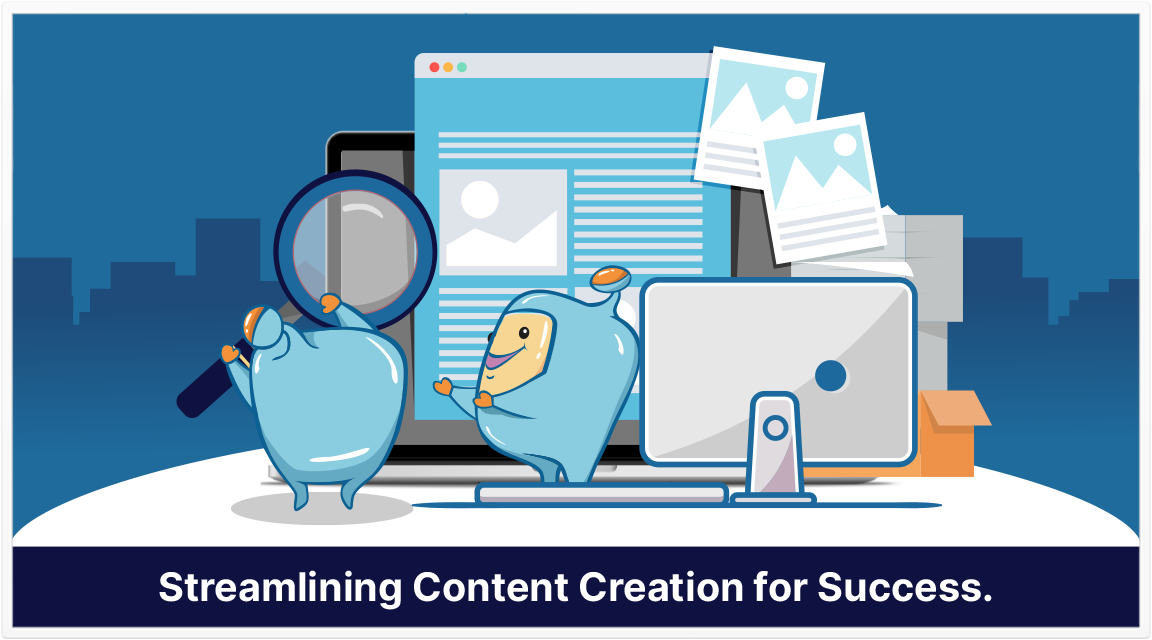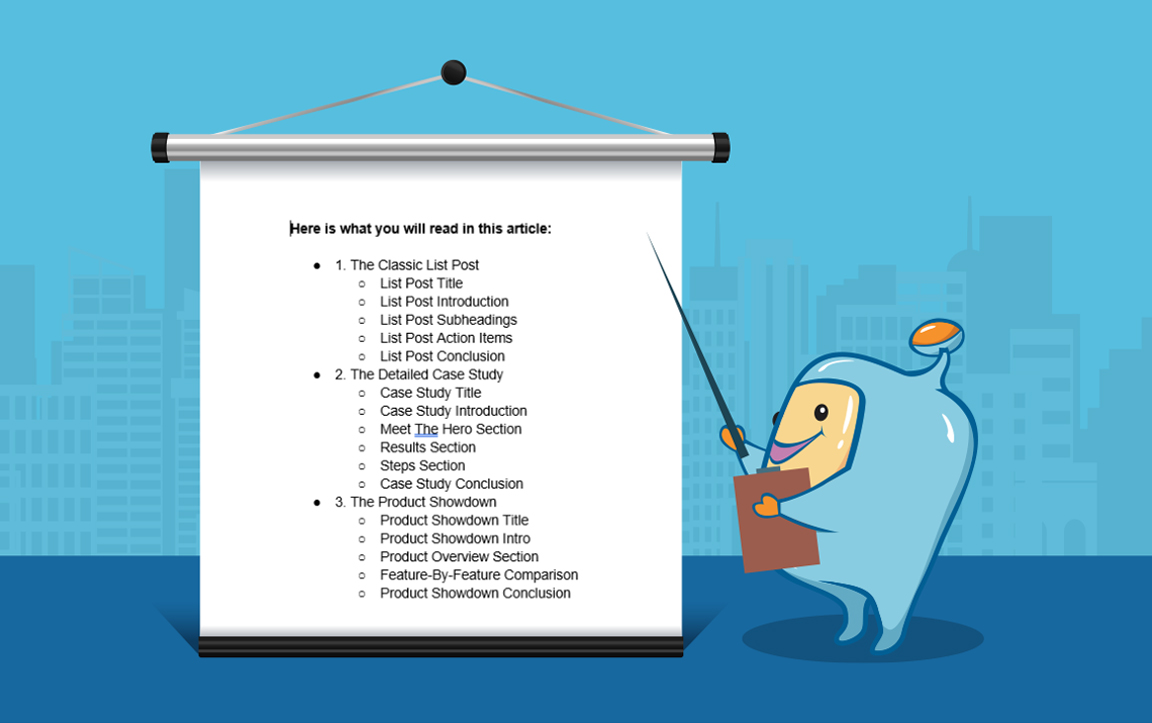Blog post templates provide a structured approach to crafting engaging and informative articles that captivate your audience and drive results.
Whether you're a seasoned blogger or just starting out, these templates offer a variety of formats to suit different purposes and topics.
From list posts to case studies, beginner's guides to myth debunkers, each template comes with its unique elements and strategies to help you create compelling content.
So, if you're ready to take your blog writing to the next level, let's dive into 7 proven blog post templates and unleash your creativity!

Here is what you will read in this article:

The Classic List Post is a widely popular and effective blog post template that revolves around creating a list of items, ideas, or tips on a specific topic.
It features a numbered format that breaks down complex ideas into easily digestible pieces of information.
In this section, we will explore how to craft an effective list post that captures the attention of your audience.
The List Post Title is a crucial element of a list post, also known as a listicle.
It serves as the headline that captures the reader's attention and sets the tone for the entire article.
The list post title should be engaging, informative, and concise, providing a clear indication of what the list post will cover.
It is important to use attention-grabbing words, such as "best," "top," "ultimate," or "essential," to highlight the value and appeal of the list.
A well-crafted list post title can pique the reader's curiosity and entice them to delve into the article to discover the insightful tips, valuable information, or entertaining content that awaits them.
The introduction of your list post should be concise and captivating.
It sets the tone for the rest of the article and entices readers to continue reading.
You can start with an intriguing fact, a thought-provoking question, or a compelling statement that grabs their attention.
Each item on your list should have a clear and descriptive subheading.
These subheadings act as signposts for readers, guiding them through the content and making it easy to scan and digest.
Make sure that each subheading accurately represents the content of the corresponding list item.
As you present each item on your list, consider including actionable tips or advice.
This adds value to your content and gives readers practical steps they can take based on the information you provide.
The action items should be specific, actionable, and relevant to the topic of your list post.
In the conclusion of your list post, summarize the key points and takeaways.
Reinforce the main benefits or lessons that readers have gained from the list.
You can also encourage them to take action or further explore the topic on their own.
End the post with a strong closing statement that leaves a lasting impression.

The Detailed Case Study is a blog post template that focuses on providing an in-depth examination of a specific case or scenario.
It is a powerful format for showcasing real-world examples, analyzing results, and sharing insights with readers.
In this section, we will explore how to create a detailed case study that captivates your audience.
The Case Study Title plays a crucial role in capturing the essence of a case study and enticing readers to explore the in-depth analysis presented in the article.
It should succinctly convey the subject matter and highlight the significance of the case study.
A well-crafted case study title grabs the reader's attention by showcasing the key elements or unique aspects of the study.
It should be clear, concise, and engaging, providing a glimpse into the value and insights that the case study offers.
A compelling case study title sets the stage for the reader, generating interest and anticipation for the detailed examination of real-world scenarios, outcomes, and lessons that lie within the article.
The introduction of your case study should provide an overview of the situation or problem you will be addressing.
Clearly state the objectives and goals of the case study, setting the stage for the in-depth analysis that follows.
In this section, introduce the main protagonist of your case study—the individual or company that achieved remarkable results using your product or service.
Provide background information, highlight their challenges, and explain why their story is worth exploring.
Present the results and outcomes achieved by the protagonist as a result of using your product or service.
Use data, statistics, and testimonials to provide evidence of their success.
Visual aids such as graphs or charts can enhance the impact of the results.
Break down the steps taken by the protagonist to achieve their desired outcome.
Explain the strategies, tactics, and approaches they used, providing detailed insights into their process.
This section should be informative, engaging, and actionable for the readers.
In the conclusion of your case study, summarize the key findings and lessons learned.
Emphasize the value and benefits of your product or service based on the case study.
Encourage readers to take action or explore how they can apply the insights from the case study in their own situations.

The Product Showdown is a blog post template that focuses on comparing and contrasting different products in a specific industry or category.
It aims to provide readers with an in-depth analysis of various products, their features, and their pros and cons.
In this section, we will explore how to create an engaging product showdown post that highlights the key features and benefits of competing products.
The Product Showdown Title serves as a focal point for comparing and contrasting different products, creating anticipation for the informative and competitive analysis that awaits the reader.
It should effectively convey the essence of the product comparison, emphasizing the competitive nature and the desire to determine the superior option.
A compelling Product Showdown Title captures attention by highlighting the key products involved and their unique selling points.
It sparks curiosity and prompts readers to delve into the detailed examination of features, benefits, and performance of the competing products.
The title sets the stage for an engaging exploration of the pros and cons, enabling readers to make informed decisions and choose the product that best meets their needs.
In the introduction of your product showdown post, set the stage by introducing the competing products and the problem they aim to solve.
Clearly state the purpose of the showdown and why it is relevant to your audience.
Grab their attention and build anticipation for the comparison that follows.
In this section, provide a brief overview of each product.
Highlight their main features, functionalities, and unique selling points.
Make sure to present the information in a clear and concise manner, allowing readers to quickly grasp the key aspects of each product.
This is the heart of your product showdown post.
Create a side-by-side comparison of the features, advantages, and disadvantages of each product.
Use tables, bullet points, or visual elements to make the comparison visually appealing and easy to follow.
Focus on the aspects that are most relevant to your audience and highlight any standout differences.
In the conclusion of your product showdown post, provide your own analysis and recommendation based on the comparison.
Summarize the key points and highlight which product you believe is the better choice and why.
Be transparent about any biases or affiliations, and encourage readers to weigh the information and make their own informed decision.

Have you ever wondered what to do after completing a specific task or milestone? This blog post template addresses that question by providing a list of actionable steps to take after accomplishing "X." Let's explore how you can create a compelling post using this template.
The Things To Do After "X" Title serves as a concise and attention-grabbing heading that immediately informs readers about the focus of the article.
It should be clear and specific, indicating that the content will provide valuable suggestions or actionable steps to take after a particular event or situation ("X") has occurred.
The title aims to capture the interest of the target audience and entice them to explore the article further.
It should be crafted in a way that sparks curiosity and conveys the benefit of reading the article to discover practical solutions or guidance for navigating the aftermath of "X."
In the introduction, explain the context and significance of completing "X." Highlight the common challenges or uncertainties that individuals may face after reaching this milestone.
Set the tone for the post and create anticipation for the valuable insights and recommendations that follow.
In this section, outline a series of actionable steps or activities that readers can undertake after accomplishing "X." Break down each step into clear and concise instructions, providing additional tips or resources where necessary.
Ensure that the steps are practical, relevant, and aligned with the specific context of completing "X."
Conclude the post by summarizing the key takeaways and emphasizing the benefits of following the suggested actions.
Encourage readers to implement the steps and share their experiences or results.
Provide a sense of closure and leave them feeling empowered and inspired to take the next steps after accomplishing "X."

A beginner's guide is an educational resource that offers a comprehensive introduction to a specific topic.
In this section, we will explore how to create a beginner's guide that provides valuable insights, clear explanations, and actionable steps for novice readers.
The Beginner's Guide Title is a key element in attracting the attention of novice learners and conveying the purpose of the article.
It should be straightforward and indicate that the content will provide comprehensive guidance and insights for beginners on a specific topic.
The title aims to create a sense of accessibility and encouragement, assuring readers that the information within the guide is tailored to their level of understanding.
It should be engaging and inspire curiosity, enticing beginners to delve into the article and gain valuable knowledge and skills.
The Beginner's Guide Title acts as a beacon for those seeking a solid foundation in the subject matter and sets the tone for an informative and educational reading experience.
In the introduction, emphasize the importance and relevance of the topic for beginners.
Explain why understanding the topic is valuable and how it can benefit the readers.
Set the expectations by outlining the key areas that will be covered in the guide, building anticipation for the knowledge and skills they will gain throughout the article.
Provide a comprehensive overview of the topic, covering the fundamental concepts, definitions, and key principles.
Break down complex ideas into easily digestible information, using simple language and relatable examples.
Help beginners build a solid foundation of knowledge on the topic.
In this section, guide beginners through a series of steps or actions they can take to further explore and understand the topic.
Present the steps in a logical order, ensuring that each step builds upon the previous one.
Provide clear instructions, tips, and additional resources to support beginners in their learning journey.
Smoothly transition from one step to the next by providing clear transitions or summaries.
Help beginners connect the dots and see the progression of their learning.
Reinforce key concepts and highlight the practical applications of the knowledge they are acquiring.
In the conclusion of the beginner's guide, summarize the key learnings and takeaways.
Reinforce the importance of the topic and the value it brings to beginners.
Encourage readers to continue their learning journey, explore additional resources, and apply the knowledge they have gained.
Leave them feeling empowered and confident in their understanding of the topic.

In a "How They Did It" post, you have the opportunity to showcase the strategies and approaches used by successful individuals or companies to achieve their goals.
In this section, we will explore how to create an engaging "How They Did It" post that provides valuable insights and inspiration.
The How They Did It Post Headline is a captivating and intriguing element that sparks curiosity in readers.
It serves as a preview of the inspiring and insightful content that follows, offering a glimpse into the success stories and achievements of individuals or businesses.
The headline aims to grab attention and entice readers to learn more about the specific strategies, approaches, or techniques that led to remarkable accomplishments.
By highlighting the "how" aspect, the headline promises valuable insights and practical knowledge that readers can apply to their own endeavors.
It sets the stage for a detailed exploration of the remarkable achievements and provides readers with a glimpse into the inner workings of successful individuals or organizations.
The How They Did It Post Headline invites readers to discover the secrets behind outstanding accomplishments and offers inspiration for their own journey towards success.
In the introduction, introduce the individuals or companies whose success stories will be featured.
Set the stage by explaining the challenges they faced and the goals they set out to achieve.
Build anticipation for the strategies and approaches that led to their success.
In this section, delve into the specific strategies and tactics employed by the individuals or companies.
Highlight their unique approaches, innovative ideas, and key decision-making processes.
Provide detailed explanations and examples to illustrate the effectiveness of their strategies.
Showcase the unique aspects of their approach that set them apart from others.
Discuss the mindset, values, or unconventional methods that contributed to their success.
Provide insights that readers can apply to their own endeavors, encouraging them to think outside the box.
Explain why the strategies and approaches used by the featured individuals or companies were successful.
Analyze the underlying principles or factors that contributed to their achievements.
Help readers understand the key elements that make these strategies effective and applicable to their own situations.
Conclude the post by summarizing the key takeaways and highlighting the inspiration and lessons readers can draw from the success stories.
Encourage readers to reflect on their own goals and consider how they can incorporate the strategies and approaches discussed in the post.
Empower them to take action and pursue their own path to success.

Myth debunker posts aim to challenge and dispel common misconceptions or myths in a specific industry or field.
In this section, we will explore how to create an engaging myth debunker post that educates and enlightens readers.
The Myth Debunker Title serves as a powerful invitation to challenge common misconceptions and debunk widely held beliefs within a particular topic or industry.
It captures the essence of shedding light on falsehoods and revealing the truth behind popular myths.
With this title, readers are immediately drawn to the prospect of unraveling long-standing misconceptions and gaining a deeper understanding of the subject matter.
The Myth Debunker Title promises an enlightening and informative journey that aims to dispel myths, separate fact from fiction, and provide readers with accurate and reliable information.
It signals an opportunity to explore the truth behind commonly held beliefs, encouraging critical thinking and a fresh perspective.
By engaging with the Myth Debunker content, readers can expand their knowledge, challenge preconceived notions, and make informed decisions based on accurate information.
In the introduction, set the stage by addressing the myth or misconceptions you will be debunking.
Explain why it is important to clarify the truth and provide accurate information.
Capture the readers' attention by highlighting the impact that believing in myths can have on their understanding or decision-making process.
Dive into the specific myths or misconceptions one by one.
Clearly state each myth and provide a concise explanation of why it is false or misleading.
Support your debunking with credible sources, data, or expert opinions.
Make sure to present the information in a clear and accessible manner, using language that is easy to understand for your target audience.
In the conclusion of your myth debunker post, summarize the key myths that have been debunked and reiterate the importance of accurate information.
Emphasize the benefits of having a clear understanding of the topic and dispelling misconceptions.
Encourage readers to critically evaluate information they come across and seek reliable sources to separate fact from fiction.
Blog post templates provide a valuable framework for creating engaging and informative articles.
Whether you choose the classic list post, the detailed case study, the product showdown, the things to do after "X" post, the beginner's guide, the "How They Did It" post, or the myth debunker, each template offers a structured approach to deliver valuable content to your readers.
By utilizing these templates, you can craft compelling blog posts that captivate your audience, provide valuable insights, and establish your expertise in your chosen field.